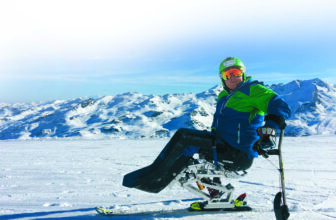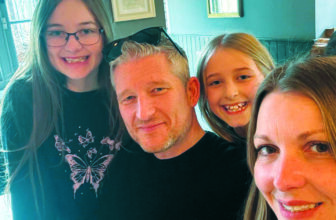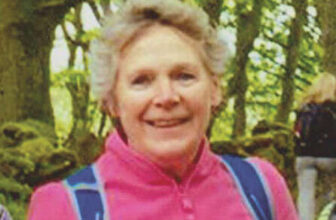
“A few months ago I found myself at the Royal Surrey, for 2 different investigations, with appointment times several hours apart. I was there to have a kidney scan at 9am, and an investigative examination at 4.30pm later that same day. Rather than stay at the hospital all day and wait between appointments, I decided to return home and come back later on, which I did” – writes Peter Patient . . .
“On my return to the hospital, I spotted a friend from Cranleigh, 93 year old John Sharp, sitting in the same waiting room queue. He was wearing a similarly unflattering hospital gown, each of us waiting to go in, hands full with baskets of our own clothes, with only our socks and shoes on! John happened to be in front of me, and next in line for his appointment.
I approached him and we exchanged pleasantries, upon which I learnt that he’d arrived at the hospital for his 9:30 appointment and had sat and waited around for his 4:30 since. John told me he’d travelled in to the hospital by bus and was intending to travel back the same way.”
“I said “No, you’re not!” “Have a lift home from me!” I suggested he waited until I’d finished and we could share the journey home in my car.
“I told him to wait until I came out. This he did, and we drove back to Cranleigh together. On the journey home, he told me about his historic, heroic past . . .”
John was a 15 year old schoolboy at Clapham Central School in South West London when war was declared with Germany in September 1939. He joined the Army at the age of 18.
He had fair hair and a pale, “British” complex- ion, and was described as a “well built, good- looking Londoner.” He made his friends feel safe. One of his army colleagues at the time even said that being around John was like: “Going for a walk with the Union Jack.”
“I joined the army in March 1942 at the age of 18 years and 9 months. I was in the Royal Armoured Corps at Bovington in Dorset to be- gin with, and from there I went to a – recently converted – infantry regiment of the Green Howards. There I was a “jack of all trades”.
My job titles included: wireless operator, gunner and a driver of armoured cars. It soon became obvious to myself and others how- ever, that if we remained with this regiment, our future would be somewhat limited, so I sought a move. Luckily, an opportunity soon presented itself.
I volunteered for special duties in what, unknown to me, turned out to be S.O.E. (Special Operations Executive). I was to be trained as a wireless operator in a very intensive course that included parachuting, shooting, coding, and unarmed combat, all to prepare me for parachuting into France to work undercover with the resistance. The unit I was in was code named: “Jedburghs”, and consisted of 100 three-man teams with a 50% survival rate of no more than six weeks. It was dangerous work.
After one abortive attempt, I was parachuted into France, behind enemy lines, near Dijon, as part of a mission to assist the French resistance in delaying German troops and sup- plies from being sent to the Normandy front where the D-Day invasion would take place.
My immediate chief was a Lt. Colonel Sir James Hutchinson, who was 51, the son of a Scottish shipowner, I was a mere 21 in comparison. He was the last serving officer out of Gallipoli in World War 1, and had been a dispatching officer for agents such as Odette. He spoke fluent french and was nicknamed the “Pimpernel of the Maquis”; he was not captured during our four months in France.
We were in an S.A.S. Sterling bomber,-the Colonel and I, plus a Major with nine other ranks. These ranks were going to the same area as us (some 200 miles behind the Normandy beachhead), but would operate entirely independently, attacking the Germans directly with the intention of delaying their reinforcements from getting to Normandy.
Unfortunately, a severe storm was raging at the time of our jump, and the pilot was unable to locate the dropping zone. We had to jump blind.
As we waited in the aircraft, I could see there was a little aperture where lights would ap- pear to warn us to be ready. The red light appeared. Such a sinister colour, commonly used to tell people to stop. Here, it beckoned us on. We fought our instincts and crept to- ward the hole in the belly of the aircraft where we jumped through, single-file, one after the other, into cold, dark, black nothingness.
We were dropped far too high, as we soon found out, at about 3000 feet! I was the last man out and ended up in a tree, the Colonel was about 400 yards away, having broken a small bone in one of his feet.
Having missed the French reception, we were subsequently lost. We all finally reunited at about 2:30am on the hillside, only to have the unfortunate pleasure of witnessing the Germans collecting all our weapons, and my wireless set, at dawn. We were left with one small box of rations and a few scant bars of chocolate. This is what we would have to live on for the next four days, subsidised by the wild berries we found on the way.
The Colonel, although senior in rank to the S.A.S. officer, had no jurisdiction over him, so it was decided we split up. Unfortunately, the S.A.S. were not so lucky as the Colonel and I, and ran into a German patrol suffering nine casualties with only their commanding officer escaping!
We then had an amazing piece of luck. After about three days with the Colonel limping badly, we came across a farm house which was an outpost of the very people we were supposed to have met. Then, of course, it was all plain sailing and another radio set was dropped to me. By the time I came up on the air, I was about two weeks late!
My job was to communicate with England, passing on information about enemy troop movements, which enabled the R.A.F to carry out a number of bombing sorties. It was quite an exciting period.
Some time later, we were finally overrun by the French 1st Army coming up from the South, and so, we journeyed back to London.
After some leave, I was asked, with others, if we would be prepared to go into Burma to do similar work as we had done in France, but this time with the Karen tribesmen. I readily agreed and on Boxing Day 1944 I was part of an organised resistance against the Japanese which jumped into the Arakan in Northern Burma as part of force 136.
We knew the fighting conditions would be much tougher than in France. There were three of us there: a Major Tom Carew who was 24 (who later became a lieutenant- colonel), a Captain Tom Cox who was 22, and myself at 21. We were not very successful on our first mission, having been chased by the Japanese after seeing us land, so we withdrew after about two months.
We tried again and were far more successful, sleeping by day and becoming a phantom army at night with the assistance of loyal Karen tribesmen who had a deep hatred of the Japanese be- cause of the atrocities they committed in their villages. They were very fond of the fearless Major Tom Carew in particular.
Conditions were awful in the jungle, no matter how clean and careful you tried to be, it was inevitable you would get malaria and dysentery. Once you became ill, you sort of stayed ill. The conditions combined with the brutal guerrilla warfare caused me to age considerably in the time I was there.
After some near misses, we were eventually overrun by units of the 14th Army (The For- gotten Army), so we returned back to base in India where I joined and trained for an operation involving landing in the advanced attack on the Japanese mainland. Fortunately for me and many others, the Atomic Bombs weren’t dropped at that time, as I think our chances of survival would have been pretty slim if they had.
Following that, it was back to the “proper Army” (as our Regimental Sergeant Major put it). After a spell of leave in England, in which I was delighted to see my family again, I was posted to an armoured car regiment as troop sergeant and I was finally demobbed in December 1946.
After the war John worked for British Steel until his retirement over thirty years ago and still lives in Cranleigh, along with his daughter Wendy and her husband Graham.
John has been married for 65 years to his beloved wife Ivy, who now resides in Knowle Park Nursing Home. He visits her nearly every day. You’ve guessed it, he usually gets there under his own steam; catching the bus to Stocklund Square and then walks down Knowle Lane to see her and have a chat!
John was awarded the Military Medal and mentioned in Despatches.
It is thanks to men and women like John that we can still live in a free country, in a nice village or town. Let’s not forget it or take for granted, the freedom of choice we enjoy and if you see John on his manoeuvres around the village, give him a wave or say hello.











